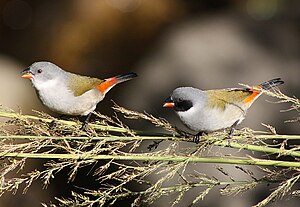Grünastrild
| Grünastrild | ||||||||||||
|---|---|---|---|---|---|---|---|---|---|---|---|---|

Grünastrild ( Estrilda melanotis ) |
||||||||||||
| Systematics | ||||||||||||
|
||||||||||||
| Scientific name | ||||||||||||
| Estrilda melanotis | ||||||||||||
| ( Temminck , 1823) |
The Grünastrild ( Estrilda melanotis ), also called black cheeks or Angola black cheeks, is an African species from the finch family . The Grünastrild is occasionally combined with the yellow-bellied astrike in one kind. It is also being discussed whether the subspecies Estrilda melanotis bocagei is an independent species.
description
The Grünastrild reaches a body length of nine to ten centimeters and is one of the smallest species of finch. The males are bluish gray on the top of the head and on the back of the neck. The sides of the head and the throat are black. The goiter and the sides of the neck are whitish and then merge with the blue-gray of the chest. The rear breast, the middle of the abdomen and the under tail covers are dull yellow. The back and the wings are olive green and yellowish overlay in some individuals. The rump and the upper tail-coverts are bright red. The tail is black. The upper beak is black, the lower beak pink to red.
The females lack the black on their heads. Unlike the males, they have a white-gray throat and white-gray head sides. They are generally duller in color, the rump and the upper tail-coverts appear yellowish red on them. The young birds resemble the females, but are more dull and brown in color. Their beak is still completely black.
distribution
Grünastrilde occur in two spatially widely separated populations in Angola and in southern Africa. The nominate form E. m. melanotis occurs from southern and eastern South Africa to Zimbabwe , Lesotho and the southwest of Mozambique . The subspecies E. m. bocagei inhabits the far north of Namibia and the highlands of southern Angola. The habitat of the Grünastrild are evergreen mountain forests and the cloud forest of the Drakensberg . In the lowlands it is mainly found in coastal vegetation as well as in gardens and overgrown cultivated land.
Way of life
Grünastrilde live in pairs or in groups of up to fifteen individuals. Unlike other fine finches, they do not socialize with flocks of other species. The diet consists of plant seeds and small arthropods . The seeds of Pennisetum setaceum , a species of the pennon cleaner grass genus, are of particular importance in nutrition . The breeding season varies somewhat depending on the distribution area and falls, for example, in KwaZulu-Natal in the period November to April and in the east of the Cape region in the months of November to January. For the populations native to northern Namibia and Angola, no information is available yet. Grünastrilde build a spherical nest in thick bushes. The clutch consists of three to nine, but mostly four or five white eggs. It is incubated by both parent birds alternately. The breeding season is 14 days, the nestling season 21. The nestlings are fed by both parent birds. After they have fledged, the young birds will follow the female parent bird and beg them for food.
The breeding parasite of the Grünastrild is the Dominican widow .
attitude
Grünastrilde were first introduced to Germany by Carl Hagenbeck in 1869. After that, it was only ever available on the market sporadically and in small numbers. It is still one of the rarities that rarely come onto the market. The species is bred, but the re-breeding rates are apparently insufficient to compensate for the losses. Housing experience indicates that Grünastrilde must be housed in sufficiently large aviaries and that if they are too small they become fat very quickly.
supporting documents
literature
- Horst Bielfeld : Knowing and caring for 300 ornamental birds. Ulmer Verlag, Stuttgart 2009, ISBN 978-3-8001-5737-2 .
- Peter Clement , Alan Harris, John Davis: Finches and Sparrows. An Identification Guide. Christopher Helm, London 1993, ISBN 0-7136-8017-2 .
- C. Hilary Fry , Stuart Keith (Eds.): The Birds of Africa. Volume VII. Christopher Helm, London 2004, ISBN 0-7136-6531-9 .
- Jürgen Nicolai (Ed.), Joachim Steinbacher (Ed.), Renate van den Elzen, Gerhard Hofmann, Claudia Mettke-Hofmann: Prachtfinken - Afrika. Eugen Ulmer Verlag, Stuttgart 2007, ISBN 978-3-8001-4964-3 . (Series Handbook of Bird Care)
Web links
- BirdLife Fact , May 30, 2010
- AVIBASE , June 18, 2010
- Estrilda melanotis inthe IUCN 2013 Red List of Threatened Species . Listed by: BirdLife International, 2012. Retrieved November 24, 2013.
